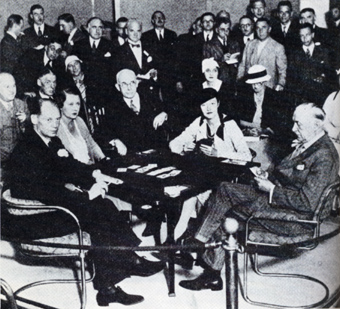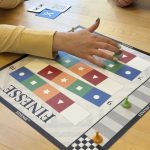In this brief bridge kibitzing guide we’ll share with you everything you need to know about watching great bridge players, or friends, play bridge events nd tournaments.
How Can I Watch Bridge? A Brief Bridge Kibitzing Guide

How Can I Watch Bridge? A Brief Bridge Kibitzing Guide
by Alex J Coyne is © 2020 Great Bridge Links
How can I watch? is a common question from bridge players who are either new to the game or returning to their love for it years after they’ve last played.
Around these parts, watching the game from afar is referred to as kibitzing (to kibitz, as kibitzer) and in the world of online bridge, your favourite match or player is only a few clicks away from the nearest device.
In this brief bridge kibitzing guide we’ll share with you everything you need to know, with some great bridge links included.
A Brief Guide (to the Bridge Battle of the Century)
The Bridge Battle of the Century is one of the most famous (and most-viewed) bridge games ever played, known for its huge audience.
Occurring between December 1931 and January 1932, the rubber game pitted Ely Culbertson’s Blue Book bidding system up against the Official System of the time preferred by Sidney Lenz. The resulting battle saw their bridge partners shift like musical chairs, with Culbertson finally winning.
In those days bridge was very much a spectator sport! The public tuned in for daily radio broadcasts and newspaper articles covering the Bridge Battle as it happened. The match attracted a mass audience, and was front-page news across the world. Widely reported on the radio, NBC aired a fifteen-minute radio broadcast on the match each night.
The result? The match was for 150 rubbers and ran from December 1931 into January 1932. Lenz and Jacoby led through 43 rubbers, but then fell behind. Jacoby quit after the 103rd rubber. Culbertson built up a lead that grew to 20,535; Lenz made up some of that gap but still finished 8,980 behind. (Source: Wikipedia)
At live bridge events in the modern world, pre-pandemic, kibitzers are allowed at a table, but there are some rules and guidelines. And you won’t be able to kibitz world championship events. These and many other high-level bridge games provide what is known as a Vugraph (see our article about vugraphs here).
Common Questions About Kibitzing
Originally, the word kibitzing is Yiddish; it means to watch from the sidelines (though not necessarily sport-related) whilst offering commentary on the event that, technically isn’t asked for.
Kibitzing means watching, and “to kibitz” means to view a bridge, as a spectator, a game being played.
Where can I watch bridge?
Pre-pandemic, when bridge was played in person at tables in large ballrooms and clubhouse space, and in post-pandemic times, people are welcome to kibitz a table. It’s polite to ask the players first, and always wait until the present hand is completed before pulling up a chair. Best to actually wait until the ’round’ is over if it’s a regular game. If it’s a team game, try to ask before a match begins. Many of the most famous and word’s best players have a regular cadre of kibitzers following them around the room.
When you are kibitzing, you do not talk. You sit back and try to be as inconspicuous as possible. And you do not kibitz more than two hands at a time.
During the pandemic, while clubs and tournaments are shut down, live bridge matches can be viewed on most of the world’s major online bridge platforms (e.g. BBO, Funbridge and others). Scroll down for a more comprehensive list of kibitzing guides and available kibitzing platforms. Recorded and streamed bridge matches are also available via websites like YouTube, Periscope or Twitch. And note that some of the higher-level games will have ‘delayed’ kibitzing to guard against cheating – see below for more details.
Here are some Twitch links that might be fun
e-Open Championship Bridge on Twitch : Streaming bridge All Stars Match vs Eopenbridge https://www.twitch.tv/eopenbridge
Canadian Bridge Championship Bridge on Twitch https://www.twitch.tv/canadabridge
Who should be watching bridge?
Anyone and everyone. Kibitzers are absolutely welcome and appreciated by the players.
Kibitzing is something that’s done by both novice players and experienced ones. It’s also done by people who don’t play bridge, but who love cards and competitive sports. If you’re a bridge player, kibitzing is a unique glimpse into other players and their techniques – and an opportunity to learn from the best players in the world.
Self-kibitzing?
You may have heard this term recently as various players have been stepping up to confess. The first was on Bridge Winners July 13, written by Michal Nowosadzki. You can read his confession here. Self-kibitzing refers to a way of cheating bridge where the cheater has more than one account and signs up as a kibitzer to view all the hands in a game while playing their own seat from another account.
Since March 2020 over 30 top bridge experts have been found cheating in high-level online tournaments. Most of these players “self-kibitzed.” Read Eldad Ginossar’s article The 2020 Online Cheating Scandal to find out more.
Delayed Kibitzing
As mentioned above, Delayed Kibitzing is sometimes employed to prevent cheating through self-kibitzing. It is a form of live-match viewing where the kibitzing stream is set to broadcast a couple of minutes after the actual play of the hand. It’s often an available setting for online club managers and tournament directors – and it’s there to discourage cheaters from self-kibitzing their way through a match they’re involved in.
What is hand view in kibitzing mode?
Hand view means the amount of participating hands the system allows the kibitzer to see. Usually, this is a setting that can be toggled by the administrator or manager of the bridge table (together with setting a delay on the kibitzing broadcast, or not).
How (& Where) to Kibitz
Here’s how to view bridge games on various online bridge platforms; just click on the appropriate name to be taken straight to the individual how-to guide. Visit our Play Online section to find more online play clubs and tournament locations.










